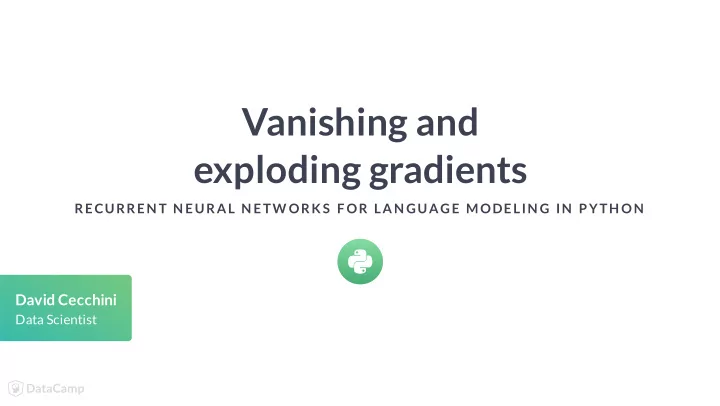

Vanishing and exploding gradients RECURREN T N EURAL N ETW ORK S F OR LAN GUAGE MODELIN G IN P YTH ON David Cecchini Data Scientist
Training RNN models RECURRENT NEURAL NETWORKS FOR LANGUAGE MODELING IN PYTHON
Example: a = f ( W , a , x ) 2 1 2 a = f ( W , f ( W , a , x ), x ) 0 1 2 a a RECURRENT NEURAL NETWORKS FOR LANGUAGE MODELING IN PYTHON
Remember that: = f ( W , a , x ) a T −1 T a T a also depends on a which depends on a and W , and so on ! T −1 T −2 T a RECURRENT NEURAL NETWORKS FOR LANGUAGE MODELING IN PYTHON
BPTT continuation Computing derivatives leads to ∂ a t a t −1 = ( W ) g ( X ) ∂ W a a t −1 ( W ) can converge to 0 or diverge to +∞ ! RECURRENT NEURAL NETWORKS FOR LANGUAGE MODELING IN PYTHON
Solutions to the gradient problems Some solutions are known: Exploding gradients Gradient clipping / scaling Vanishing gradients Better initialize the matrix W Use regularization Use ReLU instead of tanh / sigmoid / softmax Use LSTM or GRU cells! RECURRENT NEURAL NETWORKS FOR LANGUAGE MODELING IN PYTHON
Let's practice! RECURREN T N EURAL N ETW ORK S F OR LAN GUAGE MODELIN G IN P YTH ON
GRU and LSTM cells RECURREN T N EURAL N ETW ORK S F OR LAN GUAGE MODELIN G IN P YTH ON David Cecchini Data Scientist
RECURRENT NEURAL NETWORKS FOR LANGUAGE MODELING IN PYTHON
RECURRENT NEURAL NETWORKS FOR LANGUAGE MODELING IN PYTHON
RECURRENT NEURAL NETWORKS FOR LANGUAGE MODELING IN PYTHON
No more vanishing gradients The simpleRNN cell can have gradient problems. The weight matrix power t multiplies the other terms GRU and LSTM cells don't have vanishing gradient problems Because of their gates Don't have the weight matrices terms multiplying the rest Exploding gradient problems are easier to solve RECURRENT NEURAL NETWORKS FOR LANGUAGE MODELING IN PYTHON
Usage in keras # Import the layers from keras.layers import GRU, LSTM # Add the layers to a model model.add(GRU(units=128, return_sequences=True, name='GRU layer')) model.add(LSTM(units=64, return_sequences=False, name='LSTM layer')) RECURRENT NEURAL NETWORKS FOR LANGUAGE MODELING IN PYTHON
Let's practice! RECURREN T N EURAL N ETW ORK S F OR LAN GUAGE MODELIN G IN P YTH ON
The Embedding layer RECURREN T N EURAL N ETW ORK S F OR LAN GUAGE MODELIN G IN P YTH ON David Cecchini Data Scientist
Why embeddings Advantages: Reduce the dimension one_hot = np.array((N, 100000)) embedd = np.array((N, 300)) Dense representation king - man + woman = queen Transfer learning Disadvantages: Lots of parameters to train: training takes longer RECURRENT NEURAL NETWORKS FOR LANGUAGE MODELING IN PYTHON
How to use in keras In keras: from keras.layers import Embedding model = Sequential() # Use as the first layer model.add(Embedding(input_dim=100000, output_dim=300, trainable=True, embeddings_initializer=None, input_length=120)) RECURRENT NEURAL NETWORKS FOR LANGUAGE MODELING IN PYTHON
Transfer learning Transfer learning for language models GloVE word2vec BERT In keras: from keras.initializers import Constant model.add(Embedding(input_dim=vocabulary_size, output_dim=embedding_dim, embeddings_initializer=Constant(pre_trained_vectors)) RECURRENT NEURAL NETWORKS FOR LANGUAGE MODELING IN PYTHON
Using GloVE pre-trained vectors Of�cial site: https://nlp.stanford.edu/projects/glove/ # Get hte GloVE vectors def get_glove_vectors(filename="glove.6B.300d.txt"): # Get all word vectors from pre-trained model glove_vector_dict = {} with open(filename) as f: for line in f: values = line.split() word = values[0] coefs = values[1:] glove_vector_dict[word] = np.asarray(coefs, dtype='float32') return embeddings_index RECURRENT NEURAL NETWORKS FOR LANGUAGE MODELING IN PYTHON
Using the GloVE on a speci�c task # Filter GloVE vectors to specific task def filter_glove(vocabulary_dict, glove_dict, wordvec_dim=300): # Create a matrix to store the vectors embedding_matrix = np.zeros((len(vocabulary_dict) + 1, wordvec_dim)) for word, i in vocabulary_dict.items(): embedding_vector = glove_dict.get(word) if embedding_vector is not None: # words not found in the glove_dict will be all-zeros. embedding_matrix[i] = embedding_vector return embedding_matrix RECURRENT NEURAL NETWORKS FOR LANGUAGE MODELING IN PYTHON
Let's practice! RECURREN T N EURAL N ETW ORK S F OR LAN GUAGE MODELIN G IN P YTH ON
Sentiment classi�cation revisited RECURREN T N EURAL N ETW ORK S F OR LAN GUAGE MODELIN G IN P YTH ON David Cecchini Data Scientist
Previous results We had bad results with our initial model. model = Sequential() model.add(SimpleRNN(units=16, input_shape=(None, 1))) model.add(Dense(1, activation='sigmoid')) model.compile(loss='binary_crossentropy', optimizer='sgd', metrics=['accuracy']) model.evaluate(x_test, y_test) $[0.6991182165145874, 0.495] RECURRENT NEURAL NETWORKS FOR LANGUAGE MODELING IN PYTHON
Improving the model T o improve the model's performance, we can: Add the embedding layer Increase the number of layers Tune the parameters Increase vocabulary size Accept longer sentences with more memory cells RECURRENT NEURAL NETWORKS FOR LANGUAGE MODELING IN PYTHON
Avoiding over�tting RNN models can over�t T est different batch sizes. Add Dropout layers. Add dropout and recurrent_dropout parameters on RNN layers. # removes 20% of input to add noise model.add(Dropout(rate=0.2)) # Removes 10% of input and memory cells respectively model.add(LSTM(128, dropout=0.1, recurrent_dropout=0.1)) RECURRENT NEURAL NETWORKS FOR LANGUAGE MODELING IN PYTHON
Extra: Convolution Layer Not in the scope: model.add(Embedding(vocabulary_size, wordvec_dim, ...)) model.add(Conv1D(num_filters=32, kernel_size=3, padding='same')) model.add(MaxPooling1D(pool_size=2)) Convolution layer do feature selection on the embedding vector Achieves state-of-the-art results in many NLP problems RECURRENT NEURAL NETWORKS FOR LANGUAGE MODELING IN PYTHON
One example model model = Sequential() model.add(Embedding( vocabulary_size, wordvec_dim, trainable=True, embeddings_initializer=Constant(glove_matrix), input_length=max_text_len, name="Embedding")) model.add(Dense(wordvec_dim, activation='relu', name="Dense1")) model.add(Dropout(rate=0.25)) model.add(LSTM(64, return_sequences=True, dropout=0.15, name="LSTM")) model.add(GRU(64, return_sequences=False, dropout=0.15, name="GRU")) model.add(Dense(64, name="Dense2")) model.add(Dropout(rate=0.25)) model.add(Dense(32, name="Dense3")) model.add(Dense(1, activation='sigmoid', name="Output")) RECURRENT NEURAL NETWORKS FOR LANGUAGE MODELING IN PYTHON
Let's practice! RECURREN T N EURAL N ETW ORK S F OR LAN GUAGE MODELIN G IN P YTH ON
Recommend
More recommend